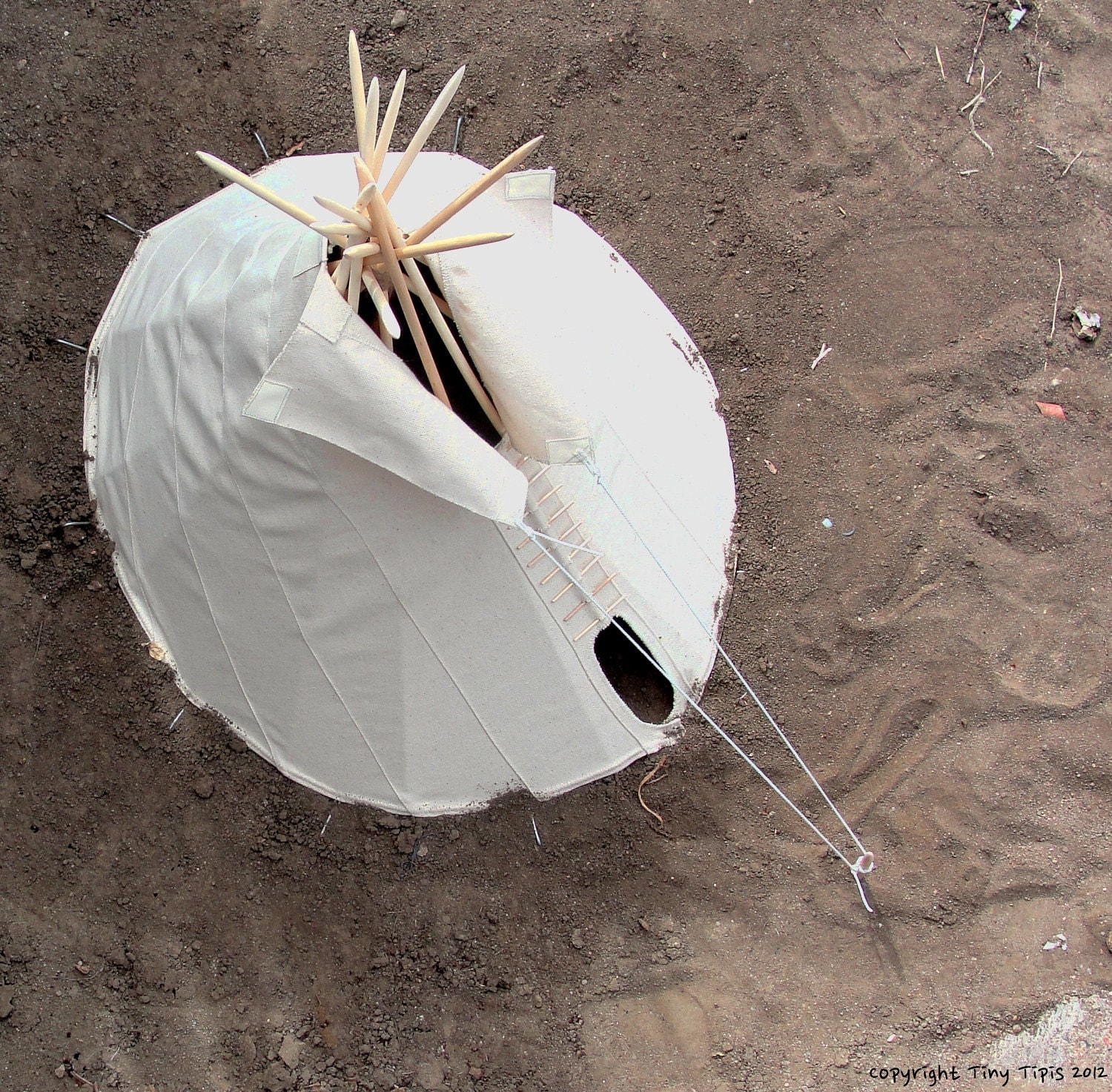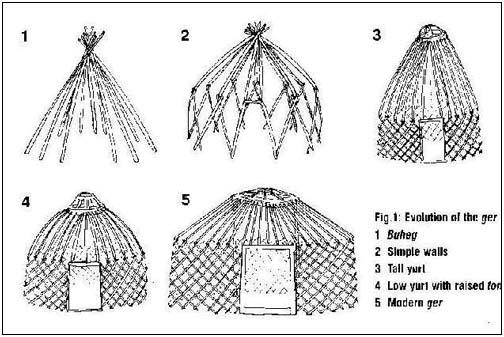Rufus,
I like your holistic mind-set. It is key for making the best go of things, especially for staying humble and ready to take in lessons when dealing with old and new and environmental designs for living.
About sweeping the snow off as it comes:
I'm pretty glued to this point. It is a simple step that does not take much time. Yes, if there was a big boat-load of snow that came overnight one night, or say over a few days if the tipi dweller was away for a bit, then knocking the snow off would be harder, but not necessarily unreasonable. It is definitely one of the easiest tasks of the tipi-homesteader. And letting a tonne of snow sit on the tipi can be detrimental to the canvas since it adds extra tension and can tear the canvas. The situation of our torn doorway happened in part due to added tension from heavy snow and ice build-up. I can't see how repairing tears in the canvas and dealing with a quicker on-set of mould from having the canvas stay wet, and then possibly having to replace the entire canvas earlier than a regularly swept canvas is the better route than just sweeping the stuff off as it comes, even if it's a lot of snow at once. If you can't do it on your own, call a neighbour. If your neighbour is trapped in their home, well, you probably are too. I think extreme snow that can't be swept off is too hypothetical, and good care of the kanvas kone should not be excused for that reason.
Water path:
Precipitation that hits the canvas cover runs down the canvas, and drips off the bottom to the ground. The tipi site is crowned, with the centre of the site being the heighest point, and the rest of the ground has a gradual outward slope away from the centre. All precipitation that hits the ground around the tipi travels down the slope and away from the tipi. There is the sunscoop berm that surrounds the site; I believe it is far away enough from the tipi that the swale between the tipi and the berm is ample enough to catch and drain precipitation, even a hearty spring thaw.
"Yes" to giving a high ranking to mould issues and health on the priority list. Especially with the black developments. Perhaps that should be another rule: any black mould, and the canvas needs immediate attention. Other priorities must be put on hold. Get another gapper to fill-in for you, or negotiate a shift in work hours in order to treat the canvas with a mould killer (lemon wash, rinse, and dry, and maybe smoke treatment). It is your home. You breathe that stuff. You need it to be safe. It'd be interesting to see how often this kind of treatment would have to happen in order to keep any mildew and mould at bay, and how much time it adds to the tipi-homesteaders' list of daily doings. An assessment of this time and process could lead to an understanding that tipi dwellers at Wheaton Labs need more time in order to properly care for their home, or more daylight hours to get this work done (working on home-improvement outside of 9-5 hours is not always realistic during the short days of winter). Or it could lead to the conclusion that the tipi project is not efficient use of time and resources, and significant changes need to be made, like transitioning to a more permanent structure around the existing tipi RMH, instead of sticking with high-maintenance, short-lifespan canvas.
I think a bigger tipi would help air flow without making changes to the existing RMH. The height of the bench is currently at a nice height that keeps the draft entering the living space at a high level, instead of directly hitting the body; but in my opinion, it is currently too close to the canvas shell. A tipi of a larger diameter would give appropriate clearance for air to flow with more ease up the back of the bench and into to the rest of the tipi. It would also have the benefit of having more storage space available for the tipi dweller, as well as more space to make adjustments along the poles. The current set-up has me on my elbows and knees to go around the outer part of the bench to make changes to the liner and check the bottom length of the poles for good rain path.
The idea of raising the tipi so that it sits on a podium is also a good consideration. Increasing the effectiveness of the RMH, or rather, the ability to eliminate/lessen heat sinks in the home, is appreciated for the canvas home steward. The reality is, a lot of fuel is burned to make-up for the draft that takes the heat away, and, I never directly considered this before, but maybe the sand floor too? We currently do not have a man-made floor, just sand. This has been a pleasant floor- it is nice to touch the ground. But it has also meant that dropping fine tools are hard to recover, and dust is ever-present in the air (mine and Derick's schnozes were of dark brown boogers), and now, maybe a consideration of it as a heat sink? An insulated podium could be worth considering. The trouble with raising the tipi to sit on a podium is the RMH- it'd have to be raised too. To rebuild it would just feel like a shame to lose the original build (but well-used and loved for 2 winters), and the podium would have to be damn sturdy to support an RMH, especially the "Mass" part. I imagine a concrete slab would have to be poured in order to support it, or something like that. Or, the heater design could be a lighter one. But then the heat would not be retained so well, and frankly, the fact that that bench holds so much heat is really the prime thing that has been carrying us tipi dwellers through the winter.
The podium reminds me of another consideration I had for lifting the tipi: a wall. My online tipi research lead me to photos of this particular tipi:


For a settled/not nomadic tipi, especially one with an RMH that does not need the bottom gap for air to flow in to feed an open campfire, a wall is a way to increase usable space, and position the canvas cover higher where the bottom edge will receive more contact with the warm interior air. This could extend the lifespan and/or decrease potential mould management for the canvas. However, it still might go mildew-y just as fast as the previous set-up since condensation might maintain the mould situation, even despite access to warmer air (that air always gets cooled down when the RMH is not being fired). Also, the wall might go mouldy, and then we have a mouldy part of the home that is much harder to replace than the canvas cover. I do like the wood storage that the photo shows in the tipi wall. But, it's not necessary, just a nice touch of added convenience. My other concern about this wall, or at least as featured in the photo, is that it is level (or at least it looks so) along the top. This is good for setting up the poles, but this surface needs to be angled away from the tipi so that rain can be directed away for the site, rather into the site. A wall with a sand core could work: the poles would find good stability in the sand, and precipitation can flow down into the sand wall and to the ground. But that wall would have to be of extremely sturdy retention walls in order to give all the necessary support to the poles and fluid sand. And then what if the shape of the wall isn't right, or the the sand is not angled outward before a winter-freeze, and melting snow ends up pooling oddly on the frozen sand. Overall I myself am not sold on this idea. It complicates the design too much and might not add any efficiency to the design, just more detail and problems to solve.
So, back to simple design, time-tested design.
The Tipi. Just a bigger one that fits the current bench better. And if the bottom rots too quickly, but the top is still ok, the bottom length of canvas can be un-hemmed, released, and replaced with a new piece of canvas. Maybe this can result in 80% of the tipi being used for 6 or so years, and the bottom being replaced every 2 years.
Or, transition to a related, but different design:
I know our canvas home is not meant for nomadic use, so going back to considering nomadic home designs might seem arbitrary. However, I think going towards a ger or yurt design could be a reasonable option for this project with the current RMH.

 1
1




 1
1




![Filename: DSC04070.JPG.png
Description: [Thumbnail for DSC04070.JPG.png]](/t/29327/a/26047/DSC04070.JPG.png)





 1
1









 2
2










 2
2




![Filename: 20150217_142551.png
Description: [Thumbnail for 20150217_142551.png]](/t/29327/a/26187/20150217_142551.png)
 1
1




 1
1





 3
3




 Have no fear, use the awl.
Have no fear, use the awl.
![Filename: 20150217_094802.jpg
Description: underside thread has been pulled too tight! [Thumbnail for 20150217_094802.jpg]](/t/29327/a/26209/20150217_094802.jpg)
![Filename: 20150217_095030.jpg
Description: pulling up the stitches on the 'user-side' while watching the underside [Thumbnail for 20150217_095030.jpg]](/t/29327/a/26210/20150217_095030.jpg)
![Filename: 20150217_095404.jpg
Description: all fixed! the 'U's on both sides have been matched-up. [Thumbnail for 20150217_095404.jpg]](/t/29327/a/26211/20150217_095404.jpg)
 2
2





![Filename: 20150217_095833.jpg
Description: [Thumbnail for 20150217_095833.jpg]](/t/29327/a/26212/20150217_095833.jpg)
 2
2




















 1
1








 2
2




 1
1








 1
1





![Filename: 20150218_111814.jpg
Description: [Thumbnail for 20150218_111814.jpg]](/t/29327/a/26222/20150218_111814.jpg)
 1
1

















 2
2









 1
1








 1
1













 4
4





 1
1




 3
3




 1
1







 4
4








 2
2






 3
3













